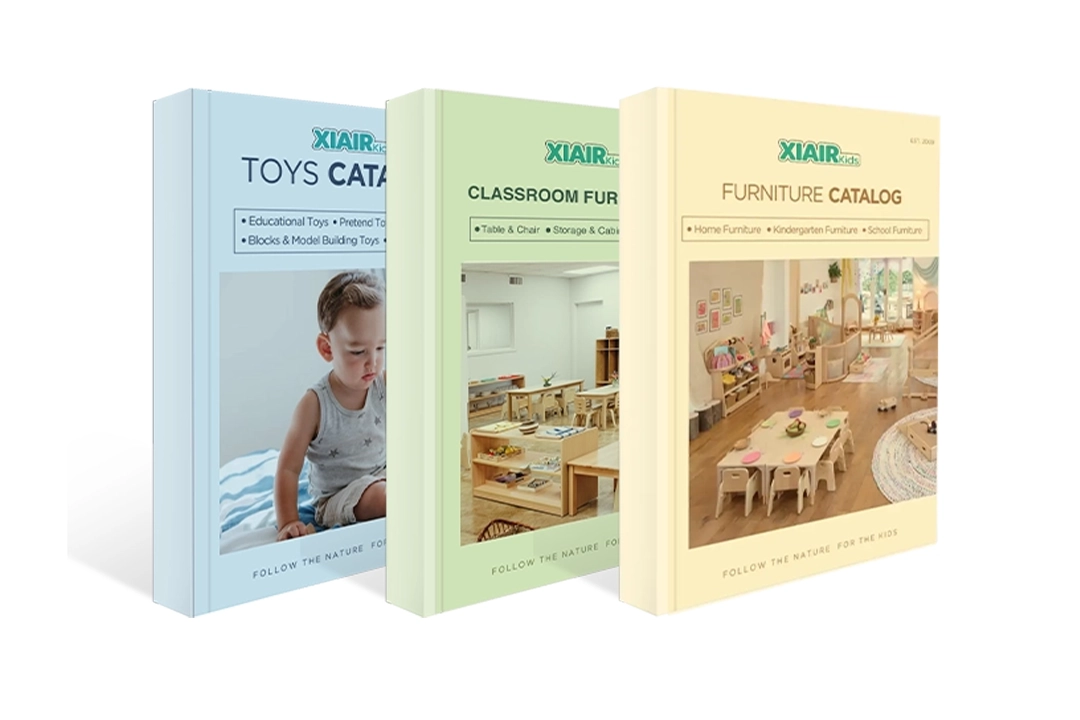Most preschool classrooms today look orderly and well-planned, but they often miss the point. Rows of identical chairs, fixed tables, and a teacher-centered layout don’t reflect how children naturally learn. These setups might be convenient for adults, but they limit children’s ability to explore, interact, and grow.
This disconnect becomes clear when we look through the lens of Lev Vygotsky Theory, which shows that learning happens best through social interaction, scaffolding, and activities within a child’s zone of proximal development. Yet many classroom environments isolate learners instead of connecting them.
The solution? Reimagine the classroom not just as a teaching space, but as a developmental space. With furniture designed for flexibility, independence, and interaction, we can build environments that align with how children really learn—and that’s where Vygotsky theory and thoughtful classroom design come together.
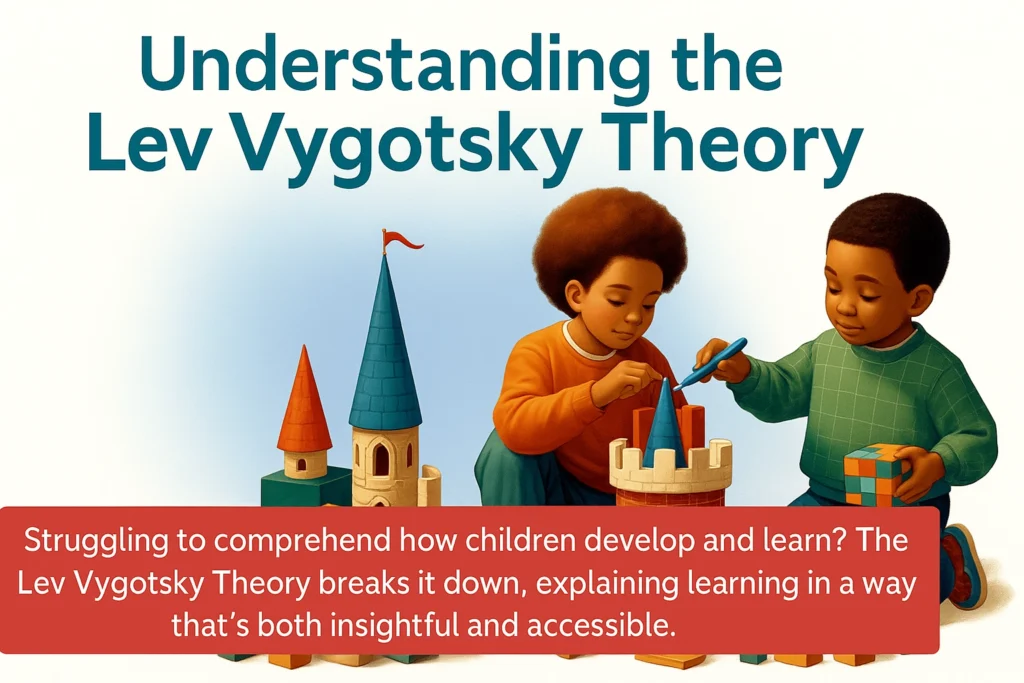
Perkenalan
The Lev Vygotsky Theory, also called the Sociocultural Theory of Cognitive Development, changed how we understand learning. Rather than seeing children as passive receivers of information, Vygotsky showed that children learn best when interacting with others in a rich, responsive environment.
In this article, we’ll explore how Vygotsky’s ideas reshape our approach to early childhood education—and how these ideas can be reflected in the physical layout of a classroom. You’ll learn:
- What Vygotsky’s core concepts are and why they matter
- How to apply them in preschool and kindergarten environments
- How your choice of furniture can support or hinder a child’s development
For educators, school leaders, and early learning professionals, this is more than theory—it’s a guide to building classrooms that support growth, engagement, and lifelong learning.
What Is the Lev Vygotsky Theory?
The Lev Vygotsky Theory is all about how children learn through people, not just paper.
Vygotsky believed that kids don’t develop in isolation. They grow through social interaction, like talking with adults, playing with friends, or listening to stories. He called this learning sociocultural because it’s shaped by both society and culture.
Another big part? Language. According to Vygotsky, it’s more than just words—it’s how kids learn to think. The moment a child says “Why?” or “What’s that?” they’re not just chatting; they’re building their understanding of the world.
So, when a classroom is filled with conversation, shared tasks, and child-led exploration, that’s a space that aligns beautifully with Lev Vygotsky Theory.
Who Was Lev Vygotsky?
Lev Vygotsky was a psychologist from early 20th-century Russia. He didn’t live long—only 37 years—but wow, did he leave an impact.
While others were measuring what kids couldn’t do yet, Vygotsky focused on what they could, especially with a bit of help. He introduced two powerful ideas: the Zone of Proximal Development and scaffolding. We’ll unpack those in a moment—but spoiler alert: they’re still used in modern classrooms today.
His work shifted the focus from test scores and stages to something more human: relationships, culture, and support. In other words, Vygotsky helped us see kids not just as learners, but as little humans growing through connection.
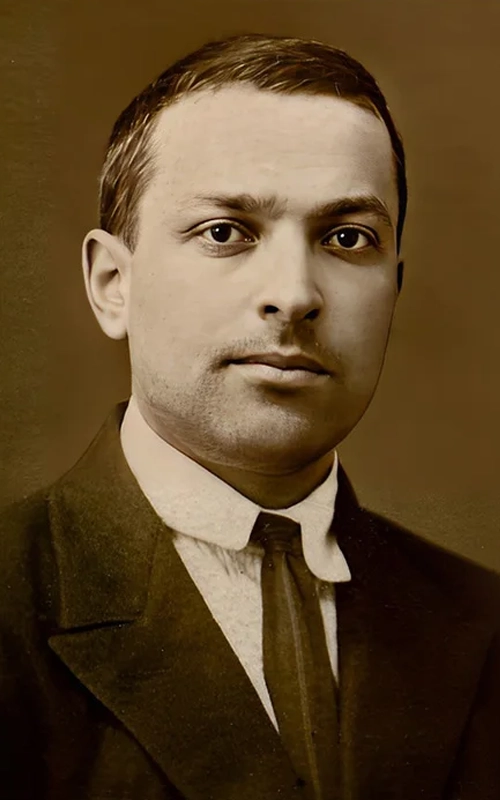
What Makes Vygotsky Theory Unique in Early Education?
Among all child development theories, the Lev Vygotsky Theory stands out for how deeply it respects the social and emotional world of young learners. While many educational approaches focus on stages, scores, or checklists, Vygotsky looked at learning as something deeply human, shared, and evolving.
So, what exactly makes his theory so unique—and still so relevant today?
Let’s break it down into three core ideas that continue to shape how modern preschools teach, design space, and support early development.
Focus on the Social Nature of Learning
At the heart of the Lev Vygotsky Theory is this simple but powerful truth: learning doesn’t happen in isolation.
Children learn through people. They observe, imitate, ask questions, and solve problems together. Whether it’s building blocks side-by-side or negotiating who gets the red crayon, these interactions are where growth happens.
This is what makes Vygotsky different—he didn’t see learning as a quiet, solo activity. Instead, he believed that social interaction drives development, especially in the early years. That’s why a child talking with a teacher or exploring with a peer isn’t wasting time—it’s precisely how they’re building understanding.
If your classroom space allows for conversation, movement, and collaboration, you’re already honoring this principle. If the layout restricts that? It might be time to rethink.
Emphasis on Language and Thought Development
In Vygotsky’s view, language isn’t just a way to talk—it’s how children learn to think.
From the moment a child asks “why” or describes what they’re doing, they’re shaping their thought process. That’s why storytelling, pretend play, and group discussions aren’t just fun—they’re essential for cognitive development.
The Lev Vygotsky Theory explains that speech starts as a social tool and gradually becomes internal. First, children talk out loud to guide themselves. Later, this turns into silent thinking. So when you hear a child whispering instructions to themselves, it’s not a distraction; it’s learning in motion.
This tells us something important about early childhood spaces: they need to encourage language. Cozy reading corners, role-play areas, and teacher-child dialogues should be part of daily life. And yes, even the furniture—like low seating for small group chats or book displays at eye level—plays a role in supporting this development.
Teachers as Facilitators, Not Instructors
In many traditional classrooms, the teacher stands at the front. The students sit quietly, listen, and follow. But Vygotsky had a different vision.
He believed that teachers should act more like guides or facilitators—offering just enough support to move a child forward, then stepping back when they’re ready to try on their own. This approach is what we now call scaffolding, and it’s one of the most practical applications of the Lev Vygotsky Theory.
In real classrooms, this could look like:
- A teacher sitting beside a child during play, gently nudging their thinking with a question.
- Helping a small group brainstorm before stepping aside and letting them explore.
- Observing first, then offering help only when truly needed.
The classroom environment should reflect this role. Open layouts, movable seating, and teacher-friendly zones allow educators to move freely, join in, and support without dominating. The right design empowers teachers to teach like Vygotsky would’ve wanted—by helping, not hovering.
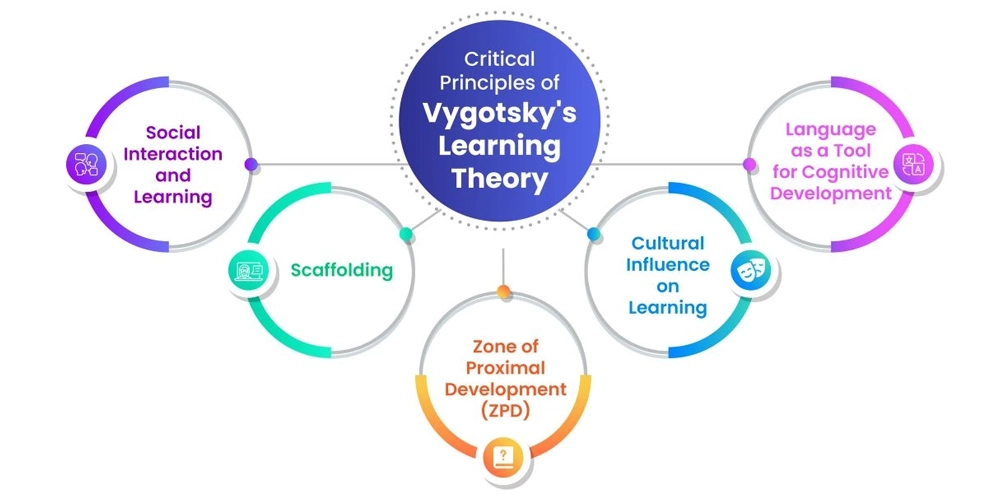
Zone of Proximal Development (ZPD)
In early childhood education, one of the most influential ideas from the Lev Vygotsky Theory is the Zone of Proximal Development, commonly known as ZPD. It offers a powerful way to understand the “sweet spot” of learning, where children are challenged just enough to grow, without being overwhelmed.
ZPD represents the gap between what a child can do on their own and what they can accomplish with guidance. When teaching, the key isn’t to hand over the solution, but to provide the proper support to help children reach the next level of understanding.
What Is ZPD in Simple Terms?
Think of ZPD as a ladder. The bottom rungs are tasks the child can already manage. The top rungs are out of reach. The ZPD lies in the middle—the rungs a child can climb, but only with someone holding the ladder steady.
This concept shifted the role of the teacher from director to facilitator of growth. Instead of focusing only on what a child knows, educators using ZPD focus on what the child is ready to learn next.
Importantly, ZPD is not static. It changes daily, even hourly. This dynamic quality is what makes it such a valuable tool in preschool settings, where development is constantly in motion.
Why the Zone of Proximal Development Matters
Adapting to Individual Learning Thresholds
Two children may appear to be at the same skill level, but have different readiness for the next challenge. ZPD encourages educators to observe closely and respond accordingly, rather than apply a one-size-fits-all approach.
By recognizing each child’s proximal learning zone, educators and caregivers can offer activities that are neither too easy nor too difficult, but designed to stretch capabilities just beyond the current level.
Designing Activities That Encourage Progression
Instead of static learning centers, classrooms can feature tiered tasks, like puzzles of varying difficulty, counting beads, or story prompts with different levels of language complexity. This gives children a chance to self-select their level of challenge while inviting them to stretch further with light support.
This approach not only promotes cognitive growth but also encourages decision-making and confidence, as children gradually learn how to assess their readiness.
Learning Through Others
ZPD emphasizes that learning is sosial. Sometimes, the support comes from a teacher. Other times, it’s from a slightly more capable peer. Children working together often unlock abilities that would remain dormant in solo activity.
That’s why preschool classrooms aligned with Vygotsky’s thinking promote collaborative play, peer interaction, and guided small-group exploration.
Real-World Examples of ZPD in Preschool
The ZPD isn’t just theoretical. Here’s what it looks like in practice:
Puzzle Table with Scaled Difficulty
A teacher invites a child to move from a 4-piece puzzle to an 8-piece version. The child hesitates. The teacher offers soft prompts like, “Can you find the corners?” Bit by bit, the child completes the task. Over time, the scaffolding fades, and success is achieved.
Peer-to-Peer Learning with Blocks
Two children build towers. One intuitively stacks for balance, the other struggles. The more experienced child offers, “Big ones go at the bottom.” A simple prompt creates a visible leap in learning—this is guided participation at its best.
Writing During Pretend Play
In the dramatic play area, a child wants to write a menu but isn’t sure how. The teacher joins in, helping sound out the word “chocolate.” It’s a low-stress, high-reward moment that builds literacy through play-based scaffolding.
Math Zone with Open Choice
In a math corner, tasks are arranged by difficulty. Children select what feels right to them, from counting objects to matching patterns. This freedom to explore, with materials intentionally curated to align with developmental stages, creates a self-scaffolded environment.
Risk-Taking in Outdoor Play
On the playground, a hesitant child watches a friend leap from a platform. With gentle encouragement from a teacher—“You can step down first if you like”—the child gathers courage, tries, and succeeds. Emotional ZPD in action.
Designing for ZPD with Furniture and Environment
The physical environment plays a quiet but essential role in supporting ZPD. Classrooms can be designed to enable children to access their learning zones independently:
- Low shelves promote self-directed activity.
- Adjustable tables and seating support peer collaboration;
- Multiple levels of task complexity encourage self-assessment and choice.
When furniture and layout are designed with ZPD in mind, the classroom becomes more than a place to sit—it becomes an active participant in each child’s learning journey.
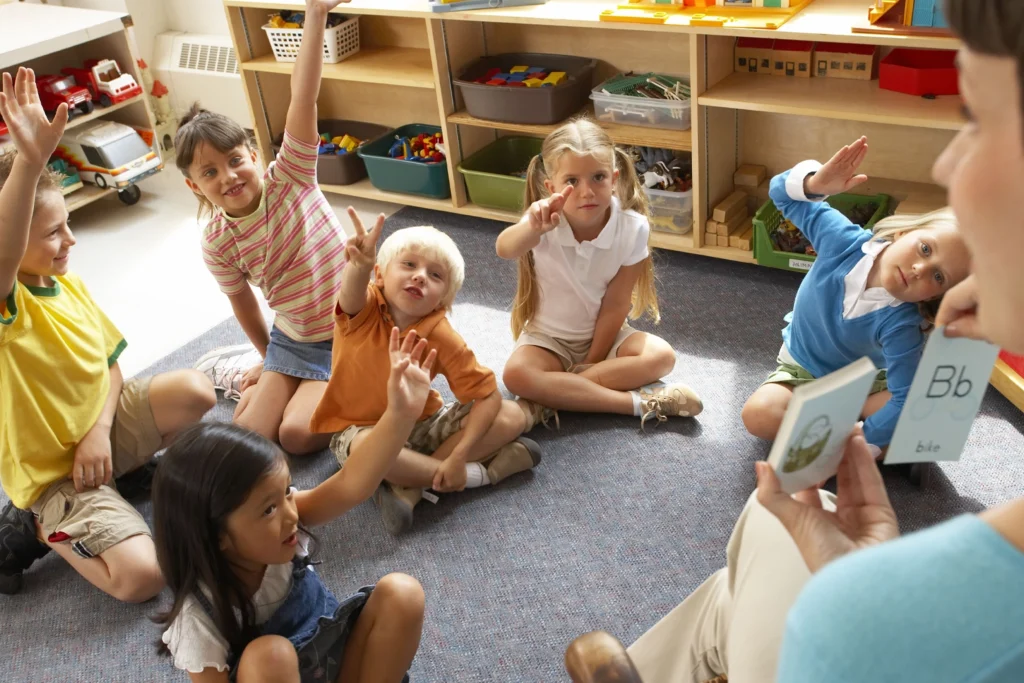
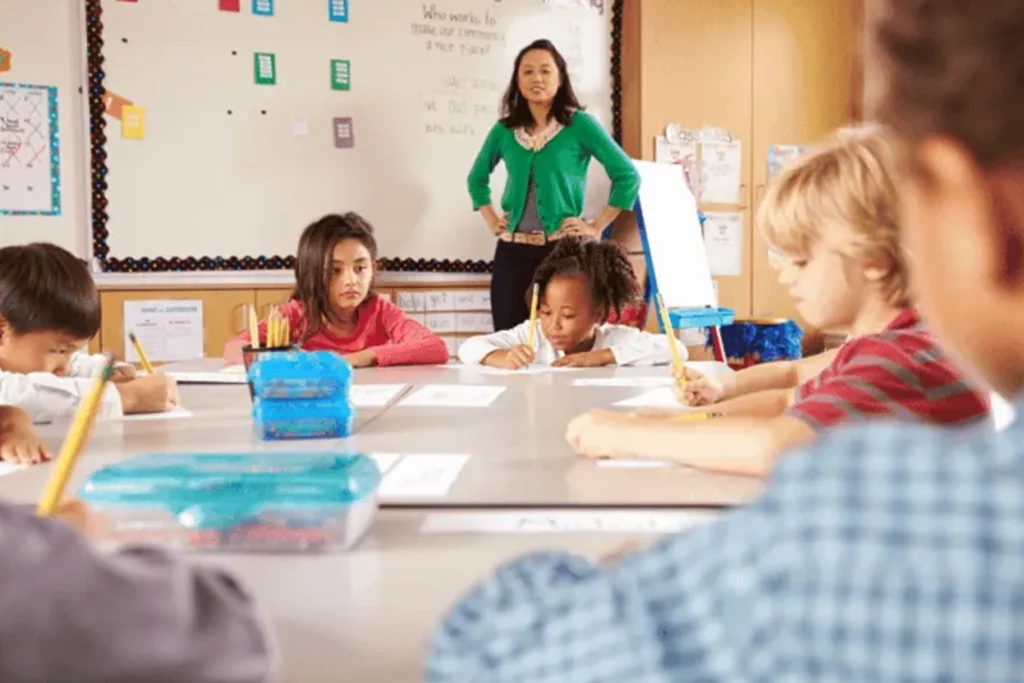
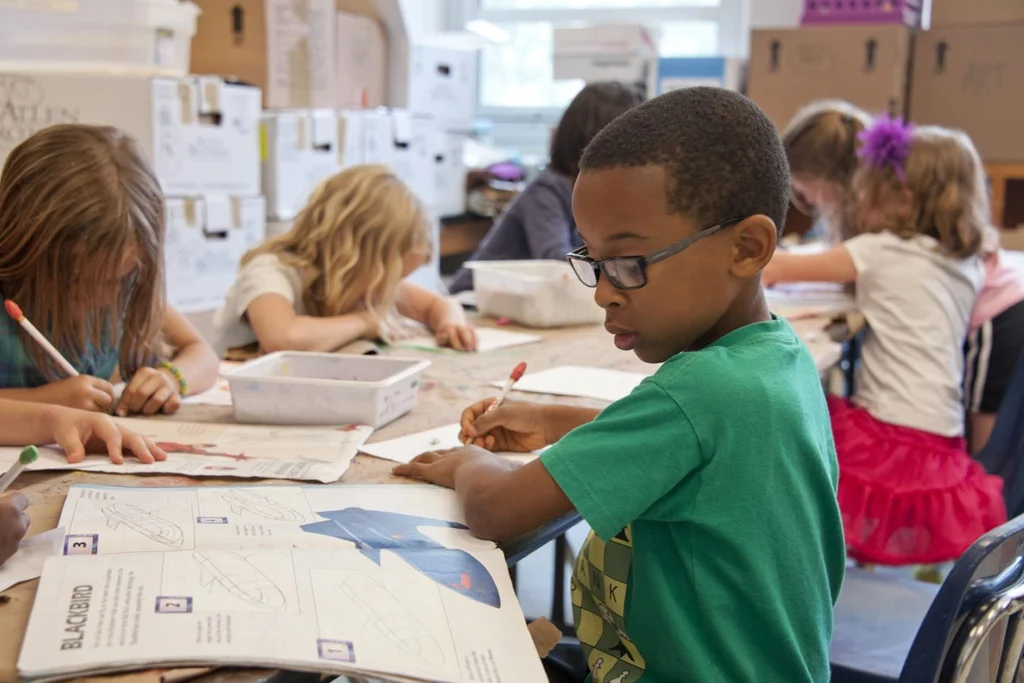
Scaffolding in Education
Among the most practical applications of the Lev Vygotsky Theory is the concept of scaffolding—a flexible, moment-by-moment approach to helping children reach their next learning goal. Unlike rigid instruction, scaffolding adjusts based on the child’s evolving needs, offering guidance when necessary and stepping back as independence grows.
Scaffolding is not a fixed method. It’s a mindset. It asks educators to observe closely, listen deeply, and respond thoughtfully—because the proper support, at the right time, unlocks growth that wouldn’t happen otherwise.
What Does Scaffolding Look Like in Preschool?
In preschool classrooms, scaffolding is everywhere—if you know how to spot it.
It’s the teacher kneeling beside a child to help them zip their coat, saying, “You hold the bottom while I pull.” It’s the peer explaining how to pour water without spilling during snack time. It’s the group working on a shared art project, with older children showing younger ones how to glue shapes in place.
These moments aren’t interruptions—they’re bridges between what a child can do now and what they’re almost ready to do.
Scaffolding is how children move through their Zone of Proximal Development in real-time.
Scaffolding Strategies Used by Effective Educators
Modeling and Demonstrating
One of the simplest forms of scaffolding is showing how something is done. Whether it’s tying shoes, sounding out letters, or using scissors safely, children learn first by watching.
- “Watch me cut along the line first.”
- “Listen how I break the word into sounds: c-a-t.”
This form of modeling gives children a reference point they can mimic and internalize.
Asking Open-Ended Questions
Instead of giving answers, effective teachers ask questions that stimulate thinking:
- “What do you think happens next?”
- “How did you figure that out?”
These prompts push children into the thinking zone, where their brains are active but not overwhelmed.
Simplifying and Sequencing
Tasks that seem too complex can be broken down into smaller, manageable steps. For example, rather than saying “Clean up the whole block area,” a teacher might say:
- “Can you start by putting the red blocks in the basket?”
This reduces cognitive load and builds a sense of mastery.
Using Visual and Verbal Cues
Charts, picture cards, step-by-step guides, and consistent language all serve as non-intrusive supports. Over time, these cues become internalized by the child, and the need for adult help fades.
Why Scaffolding Builds Confidence
Scaffolding not only boosts academic learning, it also strengthens a child’s sense of self-efficacy. When children realize, “I did it!”—even with help—they begin to believe they can try more next time.
This emotional dimension is just as important as cognitive gains. A child who feels supported is far more likely to engage, explore, and take risks.
How Preschool Environments Support Scaffolding
Scaffolding isn’t only verbal—it’s environmental too. The layout and mebel in a classroom can act as silent co-teachers, offering children the support they need without a word spoken.
Environment as the Third Teacher
In Reggio-inspired pedagogy, the classroom is considered a “third teacher.” This philosophy aligns closely with Vygotsky’s idea of indirect support.
Think about:
- Clearly labeled materials that show children what goes where;
- Shelving at eye level so children can select what they need;
- Defined learning zones that subtly suggest appropriate behaviors (quiet corner, messy art station, noisy construction area).
These structures scaffold behavior and decision-making without constant adult correction.
Furniture That Enables and Guides
Certain preschool furniture naturally supports scaffolding:
- Adjustable tables and chairs make it easier for teachers to sit at the child’s level during instruction.
- Stackable storage allows teachers to rotate materials based on current learning goals, gradually increasing difficulty.
- Collaborative furniture, like round tables or dual easels, encourages peer support, letting children scaffold each other.
Every element of the space can either promote or prevent learning. Well-designed furniture bridges the gap between ability and aspiration.
Scaffolding and the Lev Vygotsky Theory
Scaffolding is a direct expression of the Lev Vygotsky Theory in action. It’s rooted in the belief that children thrive when given targeted support—support that fades as competence grows.
It recognizes that:
- Learning is not linear;
- Support must be personalized.
- Tools, language, space, and relationships all matter.
Whether it’s helping a child spell their name or encouraging them to try a new climbing structure, scaffolding builds not only skills but also identity.
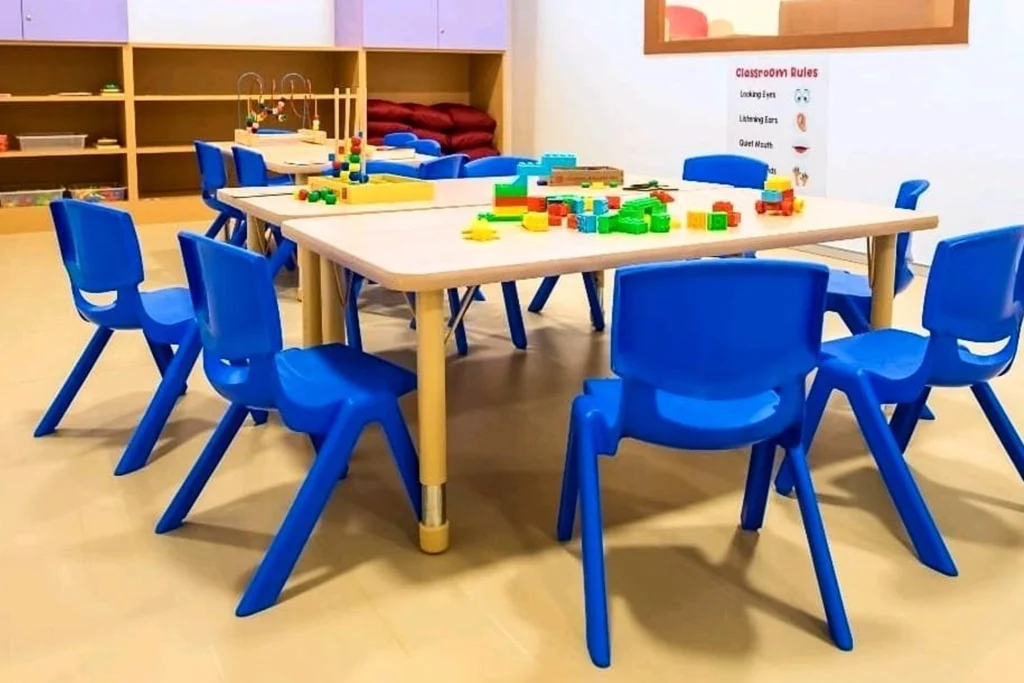

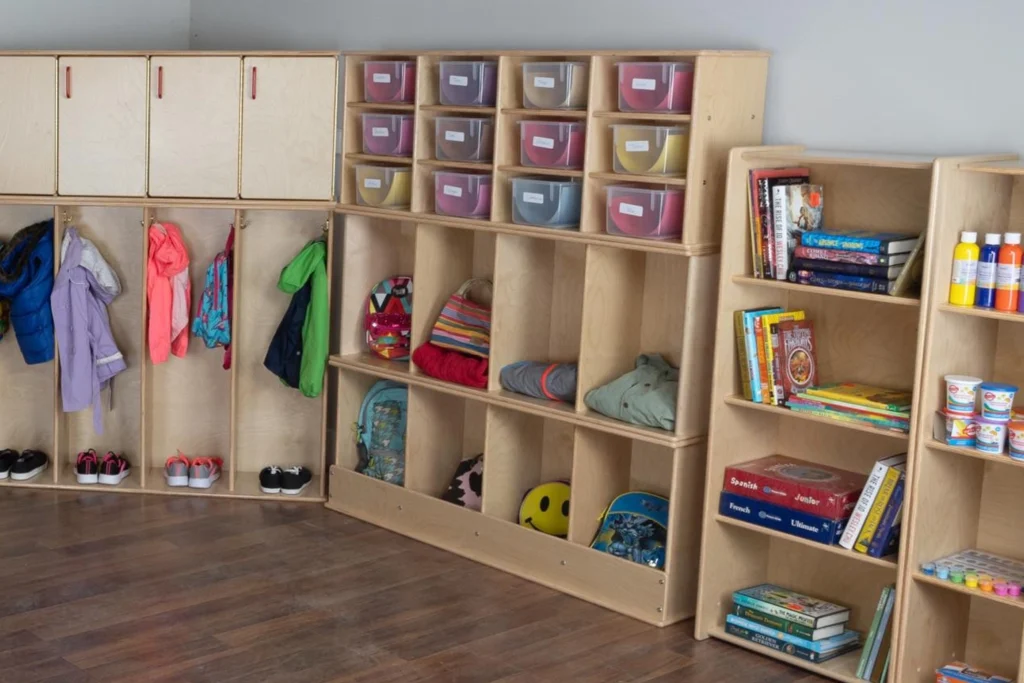
The Role of Social Interaction in Learning
In the Lev Vygotsky Theory, social interaction isn’t a bonus—it’s the foundation. Vygotsky proposed that all higher-order thinking develops first between people, and only then within the individual. This means that learning is, by nature, a social experience.
Preschool classrooms that prioritize peer engagement, dialogue, and shared activities don’t just promote better behavior—they activate learning itself. Through cooperative play, conversation, and group tasks, children internalize ideas, language, and cultural norms.
Group Activities and Peer Learning
Peer interaction is one of the most powerful tools in the early years. When children engage in small group activities, they observe strategies, model behavior, and learn cognitive flexibility.
Imagine a child learning to sort objects by shape. Alone, they may miss the concept. But sitting next to a peer who talks through their thinking—“This one’s a triangle”—the idea clicks. This is guided learning through social exposure, one of Vygotsky’s most influential contributions.
Peer scaffolding, where one child supports another, naturally activates the Zone of Proximal Development. No adult instruction necessary—just the power of interaction.
Designing Spaces for Natural Communication
In the Lev Vygotsky Theory, language is more than a skill—it’s the primary cultural tool for thinking, reasoning, and learning. And for preschoolers, language doesn’t develop in silence; it grows in spaces that invite talking, questioning, and storytelling.
That’s why a truly Vygotsky-inspired classroom must be a language-rich environment—a space where verbal interaction is as significant as the materials on the shelves.
Designing for natural communication isn’t just about reducing noise. It’s about shaping space so that dialogue happens spontaneously, not just during “circle time.”
Let’s look at how three powerful layout strategies can transform your classroom into a social, expressive, and communication-focused learning environment.
Open Layouts vs. Isolated Desks
Traditional classrooms with fixed desks in rows often create visual and physical barriers between students. In early childhood settings, this layout suppresses the very interactions that Vygotsky believed were essential to development.
An open layout does the opposite. It invites:
- Eye contact across tables;
- Shared materials at the center;
- Movement that leads to spontaneous conversations;
- Teacher mobility for natural joining and scaffolding.
Open-plan spaces encourage children to ask questions, listen to peers, and use language to collaborate—all essential components of social language development.
Flexible Seating Clusters
Grouped seating arrangements—like semicircle rugs, floor cushions, or rotating table stations—give children freedom to move between learning communities.
This supports:
- Peer-to-peer exchanges (“How did you do that?”)
- Teacher-guided dialogue in small groups;
- Rotating activities that foster varied conversations.
Even better? Child-scaled, lightweight furniture allows young learners to control their environment, fostering autonomy and reinforcing the idea that they are active participants in learning, not passive recipients.
Conversation Corners and Role-Play Zones
Some of the richest learning moments happen in the quietest corners.
A well-designed conversation area can include:
- Two small chairs facing each other;
- A low bookshelf with emotion cards or picture books;
- Soft lighting and sound-softening rugs to make dialogue feel natural.
Likewise, dramatic play spaces—like pretend kitchens, grocery stores, or doctor’s offices—become language labs where children:
- Invent roles;
- Practice social scripts.
- Negotiate ideas with peers.
These spaces should include props and signs with real words, giving children the chance to connect spoken language with print, one of the first steps toward literacy.
Design Comparison: Traditional vs. Vygotsky-Inspired Communication Spaces
To highlight how design directly affects communication potential, here’s a side-by-side comparison:
| Design Element | Kelas Tradisional | Vygotsky-Inspired Space |
|---|---|---|
| Seating Layout | Fixed rows or single desks | Open clusters, round tables, and floor zones |
| Language Interaction | Mostly teacher-to-student | Peer-to-peer, group dialogue encouraged |
| Furniture Role | Static, adult-focused | Child-sized, mobile, collaboration-friendly |
| Learning Mode | Individual tasks | Shared exploration and discussion |
| Access to Materials | Teacher-distributed | Self-serve, centrally located shared tools |
| Communication Zones | One (circle time only) | Multiple: quiet corners, drama, reading zones |
| Teacher Role | Instructor giving directions | Facilitator supporting social interaction |
Why It Matters
When a classroom is designed to foster natural conversation, it becomes a dynamic environment that supports every aspect of the Lev Vygotsky Theory:
- It values culture and community;
- It encourages language as a learning tool, not just a skill to practice.
- It gives teachers the flexibility to guide without dominating;
- And it gives children the freedom to express, question, and grow together.
In short, furniture, layout, and design either nurture or limit communication. A thoughtful space speaks volumes, even before the children do.
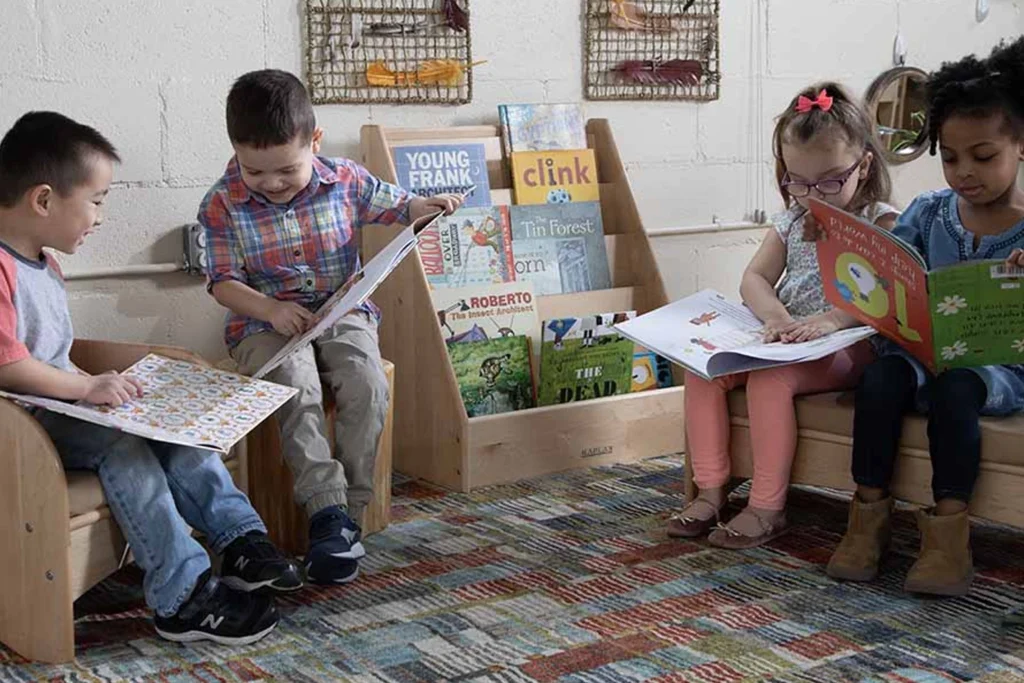
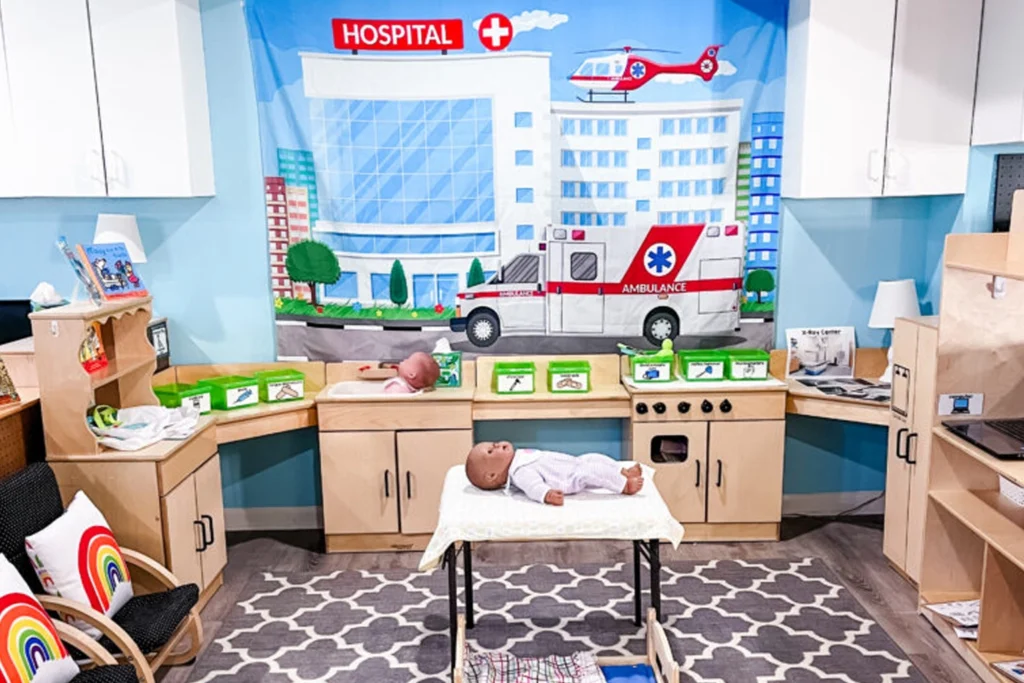
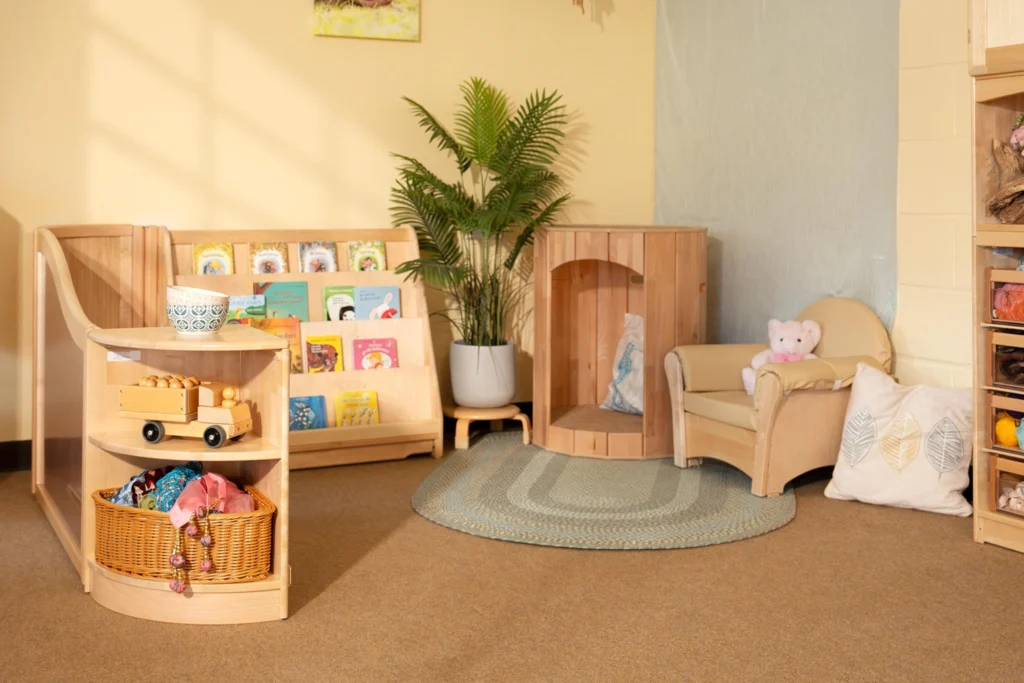
How Vygotsky Theory Applies to Preschool Classrooms
So, how do we translate the Lev Vygotsky Theory into practical preschool design and daily teaching? The key is to build environments where scaffolding, peer learning, and ZPD-supportive experiences can unfold naturally.
This means moving away from “decorated rooms” toward intentional learning ecosystems, where space, materials, and adult roles all adapt to the child’s readiness level.
Creating a ZPD-Friendly Classroom
Designing for the Zone of Proximal Development requires flexibility. A ZPD-friendly classroom doesn’t assume all children are on the same page. Instead, it:
- Offers multi-level tasks at every learning center;
- Features graduated tools (e.g., puzzles, art prompts, math manipulatives) so children can self-assess and stretch;
- Has a clear organization so children can navigate independently and with guidance.
For example, a writing center might have:
- Picture-word cards for early learners;
- Phonics games for those in transition.
- Sentence strips for advanced storytellers.
This isn’t just innovative pedagogy—it’s scaffolded spatial design in action.
Encouraging Independence While Supporting Growth
Vygotsky emphasized that children develop best with just enough help. In classroom terms, this means:
- Letting children choose their materials;
- Giving them time to try and fail before stepping in;
- Creating routines that foster ownership, like self-serve snack stations, clean-up charts, or job boards.
Furniture can support this too:
- Child-height storage promotes autonomy.
- Visual labels on bins reduce adult direction.
- Step stools and reach zones empower self-navigation.
When designed well, the classroom itself becomes a quiet coach, nudging children forward without pushing too hard.
Observing and Responding to Each Child’s Stage
Perhaps the most Vygotskian thing a teacher can do is observe. Development isn’t linear, and no two children hit milestones at the same time.
Teachers who know where each child is can:
- Adjust questions to match the learner’s zone.
- Group children by shared learning needs, not just age;
- Provide support only as needed, then pull back as confidence builds.
This means the classroom must be visible, navigable, and readable—so adults can quickly spot where and how to engage.
Observing and Responding to Each Child’s Stage
One of the most essential principles of the Lev Vygotsky Theory is that development is not uniform. Children do not learn in identical ways or on a fixed timeline. Instead, their growth unfolds in stages, shaped by biology, environment, culture, and especially social interaction.
In a preschool classroom grounded in the Lev Vygotsky Theory, educators are not merely delivering instruction; they are active observers—watching for clues that show where each child stands in their Zone of Proximal Development.
Observation isn’t passive. It’s the key to responsive teaching. When teachers know what a child can do independently and what they can almost do with help, they can provide targeted support that truly makes a difference.
Recognizing Developmental Differences by Age Group
To apply the Lev Vygotsky Theory effectively in a real-world preschool setting, it’s vital to recognize how developmental expectations shift by age. Children of different ages need different forms of scaffolding, language models, and spatial support.
Below is a breakdown of typical behaviors and classroom strategies for core preschool age groups:
| Kelompok Usia | Typical Developmental Traits | Teacher Focus | Environment & Furniture Recommendations |
|---|---|---|---|
| 2–3 Years | Rapid language emergence, parallel play, basic motor skills | Rapid language emergence, parallel play, and basic motor skills | Low open shelving, large manipulatives, safe soft spaces, one-on-one stations |
| 3–4 Years | Encourage peer interaction, introduce role play, and scaffold storytelling | Small group tables, dramatic play furniture, and early literacy corners | Scaffold problem-solving, promote group collaboration, and ask open-ended questions |
| 4–5 Years | Greater self-control, extended focus, early reasoning, imaginative narratives | Scaffold problem-solving, promote group collaboration, and ask open-ended questions. | Task-based stations, multi-level challenge zones, writing and thinking corners |
This type of age-sensitive classroom structure aligns perfectly with Lev Vygotsky Theory, ensuring each child’s learning environment matches their developmental needs while also offering access to the next challenge through appropriate scaffolding.
Why It Matters for Teachers and Designers
Whether you’re creating a curriculum or designing preschool furniture, understanding child development stages is critical. The Lev Vygotsky Theory teaches us that teaching must meet the child where they are, and stretch just beyond.
For example:
- A 3-year-old may benefit from guided storytelling with picture prompts.
- A 4-year-old might thrive with cooperative science stations.
- A 5-year-old may engage deeply in group-based inquiry projects.
All of these setups require furniture that’s not only age-appropriate but ZPD-aware—able to support both what children can do now and what they are almost ready to do.
When classrooms reflect these nuances, they stop being generic learning spaces. They become Vygotskian laboratories of development—designed for progress, powered by observation, and guided by the theory itself.
Putting It All Together
Preschools built around the Lev Vygotsky Theory don’t look chaotic, but they do look alive. Children move, talk, create, and collaborate. Materials are accessible, not locked away. Teachers aren’t giving answers—they’re guiding exploration.
Most importantly, every child is seen not just for who they are now, but for who they’re ready to become next.
And when the classroom reflects that belief—in its flow, its furniture, and its flexibility—Vygotsky’s legacy becomes real, not theoretical.
Ruang kelas impian Anda hanya tinggal satu klik saja!
Educational Theory Meets Practical Design
Translating educational theory into classroom design is no longer optional—it’s essential. In today’s early childhood landscape, educators, designers, and decision-makers need environments that actively support the way children develop. Among all early learning theories, Lev Vygotsky Theory offers one of the most practical blueprints for building spaces where real learning can happen.
At the heart of the Lev Vygotsky Theory is the concept that development unfolds through social interaction, guided support (scaffolding), and well-matched challenges within a child’s Zone of Proximal Development (ZPD). For preschool furniture designers, these principles aren’t just academic—they are the foundation for meaningful, growth-centered design.
How Our Furniture Embeds Vygotsky’s Principle
We begin every design process by asking a simple question: “What kind of learning does this enable?” With the Lev Vygotsky Theory in mind, that question leads us to prioritize flexibility, independence, collaboration, and visibility.
Scaffolding in Furniture Form
In a classroom rooted in the Lev Vygotsky Theory, scaffolding isn’t just verbal—it’s spatial. Our furniture reflects this by supporting a wide range of teacher-child interactions:
- Open-ended materials allow children to explore with or without help.
- Modular tables support teacher rotation for real-time guidance.
- Semi-circular layouts keep children within easy conversational distance from adults and peers.
These designs mirror Vygotsky’s belief that learning is social and responsive. A child trying to solve a puzzle near a peer who’s mastered it will often learn faster than through instruction alone. Our stations create space for those moments.
Designing for the ZPD
Learning happens best on the edge of ability. That’s why every learning center we build includes:
- Graduated materials: Activities range from beginner to advanced, encouraging children to self-select based on comfort and confidence.
- Self-paced tools: From manipulatives to literacy prompts, children choose what they’re ready for.
- Visual cues: Color-coded difficulty or step-by-step guides help children know what comes next.
Incorporating these elements ensures children remain within their Zone of Proximal Development, exactly as outlined by the Lev Vygotsky Theory.
Supporting Verbal and Social Learning
Language plays a central role in Vygotsky theory. That’s why we embed opportunities for talk and storytelling in nearly every setup:
- Dramatic play zones with social cue props;
- Shared art tables that encourage descriptive dialogue;
- Literacy centers with peer-reading stations and rotating language tools.
Each environment invites the very kind of interaction Vygotsky described: shared meaning-making in action.
Teacher-Responsive Layouts
A significant strength of our approach is how it serves educators. Teachers can’t scaffold effectively if the room isolates them from learners. That’s why our design includes:
- Mobile teacher zones for flexible intervention.
- 360° visibility from key positions;
- Layered difficulty layouts so materials can be rotated by learning readiness, not just schedule.
All of this makes scaffolding easier, both intentional and incidental.
Our approach doesn’t just reference the Lev Vygotsky Theory—it enables it to live inside the classroom.
Why Thoughtful Design Drives Child Growth
It’s not just what a classroom contains—it’s how it functions that determines its developmental value. When preschool furniture is designed with the Lev Vygotsky Theory in mind, growth becomes part of the infrastructure.
Independence Without Isolation
Vygotsky emphasized the delicate balance between autonomy and guidance. Our products reflect this:
- Child-height storage encourages self-selection.
- Transparent bins and visuals reduce adult prompts.
- Step stools, low mirrors, and self-serve counters foster self-awareness and confidence.
The environment permits children to try, to test, to retry—and eventually to succeed.
Peer Learning as a Built-in Feature
Social learning isn’t an accident—it’s a core principle of the Lev Vygotsky Theory. Our designs make space for:
- Shared learning stations that seat 2–4 children;
- Whisper zones for reading and storytelling;
- Collaborative play structures with role-sharing built in.
These micro-environments allow children to learn from one another as they move through their ZPD in different domains.
Dynamic Adaptation by Design
Development isn’t static. That’s why fixed classrooms can’t serve flexible children. Our furniture is built to evolve:
- Shelves convert to stations.
- Play kitchens become science centers.
- Reading corners double as morning meeting zones.
We support dynamic learning needs with dynamic solutions, all guided by the adaptable mindset of the Lev Vygotsky Theory.
Making Every Classroom a Developmental Space
What transforms a space from decorative to developmental? Alignment with how children grow. The Lev Vygotsky Theory insists that children are active constructors of their learning, with adult guidance and the right tools.
Environmental Cues That Promote Growth
Three principles guide each space we help create:
- Accessible autonomy: Children reach and return materials themselves.
- Social scaffolding: Layouts encourage peer help and teacher entry.
- Challenge clarity: It’s always apparent what the child can try next.
The result is a classroom that functions like a teacher, prompting, pacing, and personalizing development.
A Classroom That Sees the Child’s Future
Our approach doesn’t just support today’s learner. It anticipates what each child is almost ready for. That’s the essence of ZPD-aligned design.
- Open-ended puzzles grow with the child.
- Story starters become writing prompts.
- Role-play spaces evolve from imitation to invention.
This is how you build a classroom that grows with its children.
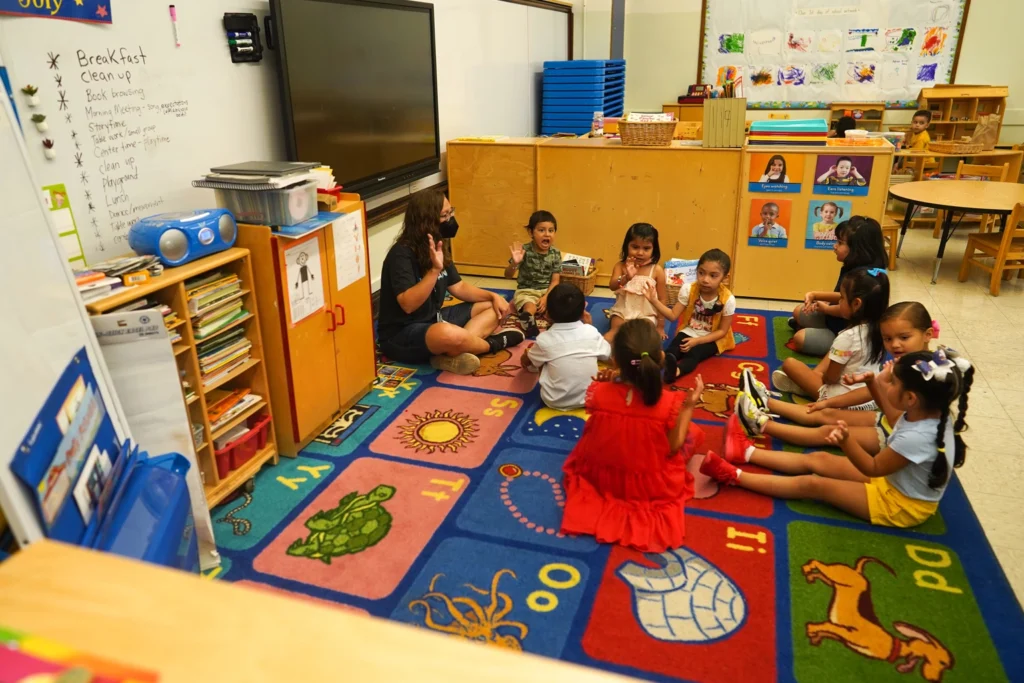
Kesimpulan
The beauty of the Lev Vygotsky Theory is that it’s not meant to stay in textbooks. It’s intended to live in classrooms, in teacher interactions, and in every child-sized table and shelf. When we understand learning as a social, scaffolded, and ever-evolving process, our approach to early childhood education changes from the inside out.
Classrooms inspired by the Lev Vygotsky Theory are not static. They’re dynamic ecosystems where play-based learning, guided discovery, and peer-supported exploration flourish. And it’s not just the curriculum that makes this possible—it’s the physical space, the materials, and the tools that surround the child every day.
Designers and educators who collaborate around this vision create more than furniture. They build flexible preschool environments where ZPD learning is not just encouraged but enabled. They offer cognitive support tools that adjust as a child’s understanding grows. They turn intentional teaching into an architectural language.
So, whether you’re curating a literacy corner, designing a sensory zone, or choosing seating that allows for both independence and collaboration, let the Lev Vygotsky Theory guide you.
Because the goal isn’t just to fill a room—it’s to shape an experience. One that meets each child at their level, respects their potential, and supports their next step—whether that’s learning a new word, solving a puzzle, or simply reaching a toy on their own.
In the end, development is not a product of chance. It’s a result of carefully crafted environments, thoughtful adult roles, and the daily interactions that bring theory to life.
And when your preschool furniture reflects that?
You’re not just designing—you’re supporting early childhood growth at every level.
Tanya Jawab Umum
1. What are the 4 principles of Vygotsky theory?
The Lev Vygotsky Theory includes four core principles: social interaction drives learning, development varies by culture, language shapes thought, and cognitive growth happens in the ZPD through guided support.
2. What are the three main concepts of Vygotsky theory?
The three key ideas in the Lev Vygotsky Theory are: the Zone of Proximal Development (ZPD), scaffolding, and the central role of social and cultural context in early childhood development.
3. What are the 5 stages of Vygotsky theory?
Vygotsky outlined five stages of speech and thought development: pre-intellectual speech, autonomous speech, naive psychology, communicative speech, and inner speech—all central to his sociocultural theory.
4. What is scaffolding in Vygotsky theory?
Scaffolding in the Lev Vygotsky Theory is the support given to children as they learn new tasks. It helps bridge the gap between what they can do alone and what they can do with help, which is essential in ZPD learning.
5. How does Vygotsky theory differ from Piaget’s?
Unlike Piaget, the Lev Vygotsky Theory emphasizes learning through social interaction. It focuses on guided discovery, cultural tools, and adult or peer support in development.
6. What are examples of Vygotsky theory in preschool?
Examples include peer learning, guided play, dramatic role areas, and multi-level activity stations—all supporting ZPD and scaffolding, as emphasized by Vygotsky’s sociocultural theory.
7. Why is ZPD essential for child development?
The Zone of Proximal Development helps identify the ideal learning range. According to the Lev Vygotsky Theory, children grow fastest with just-right challenges and the proper support.
8. How can preschool furniture support sociocultural learning?
Furniture aligned with the Lev Vygotsky Theory promotes social interaction, child autonomy, and cultural expression—key elements in supporting early childhood development.


